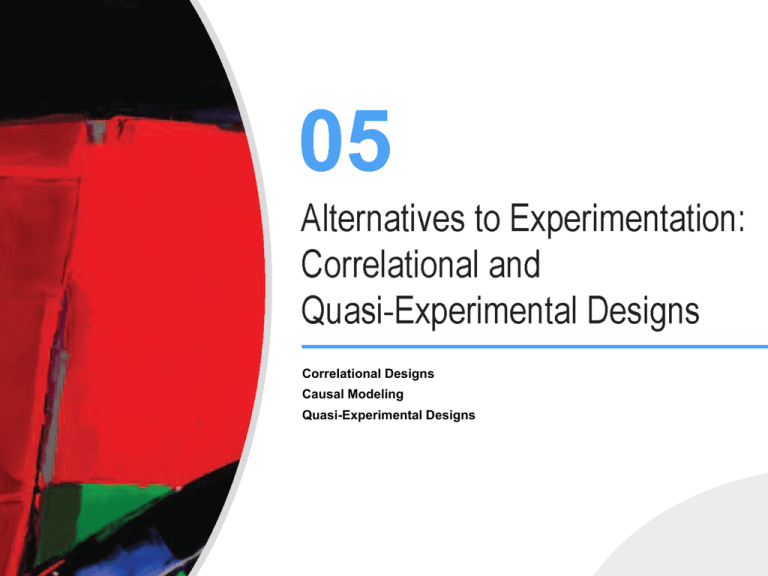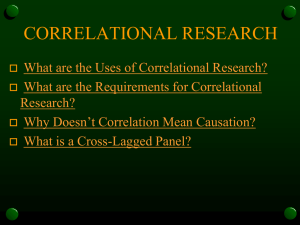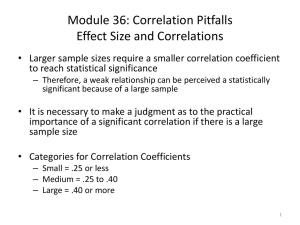Chapter 5
advertisement

Correlational Designs Causal Modeling Quasi-Experimental Designs How do quasi-experiments differ from actual experiments? Quasi means “seeming like.” Quasiexperiments superficially resemble experiments, but lack their required manipulation of antecedent conditions and/or random assignment to conditions. Correlational Designs How do quasi-experiments differ from actual experiments? They may study the effects of preexisting antecedent conditions—life events or subject characteristics—on behavior. A quasi-experiment might compare the incidence of Alzheimer’s disease in patients who used ibuprofen since age 50 and those who did not. Correlational Designs How do quasi-experiments differ from actual experiments? In experiments, researchers randomly assign subjects to antecedent conditions that they create. An experiment might randomly assign subjects to either daily ibuprofen or aspirin use, and then measure their incidence of Alzheimer’s. Correlational Designs When should we use quasi-experiments instead of experiments? We should use quasi-experiments when we cannot or should not manipulate antecedent conditions. Quasi-experiments could study the effect of spouse abuse on the frequency of child abuse. Correlational Designs Describe the properties of a correlation. A Pearson correlation coefficient is used to calculate simple correlations (between two variables) and may be expressed as: r (50) = +.70, p = .001. Correlation coefficients have four properties. linearity, sign, magnitude, and probability. Correlational Designs Describe the properties of a correlation. Linearity means how the relationship between x and y can be plotted as a line (linear relationship) or a curve (curvilinear relationship). Sign refers to whether the correlation coefficient is positive or negative. Correlational Designs Describe the properties of a correlation. Magnitude is the strength of the correlation coefficient, ranging from -1 to +1. Probability is the likelihood of obtaining a correlation coefficient of this magnitude due to chance. Correlational Designs What does a scatterplot show? Scatterplots are a graphic display of pairs of data points on the x and y axes. A scatterplot illustrates the linearity, sign, magnitude, and probability (indirectly) of a correlation. Correlational Designs How does range truncation affect correlation coefficients? Range truncation is an artificial restriction of the range of X and Y that can reduce the strength of a correlation coefficient. Correlational Designs How do outliers affect correlations? Outliers are extreme scores. They usually affect correlations by disturbing the trends in the data. Range truncation removes outliers. Correlational Designs Why should we compute the coefficient of determination? The coefficient of determination (r2) estimates the amount of variability that can be explained by a predictor variable. For example, Chaplin et al. (2000) showed that handshake firmness accounted for 31% of the variability of first impression positivity. Correlational Designs Why doesn't correlation prove causation? Since correlational studies do not create multiple levels of an independent variable and randomly assign subjects to conditions, they cannot establish causal relationships. Correlational Designs Why doesn't correlation prove causation? There are three additional reasons that correlations cannot prove causation: (1) casual direction (2) bidirectional causation (3) the third variable problem Correlational Designs Why doesn't correlation prove causation? Causal direction Since correlations are symmetrical, A could cause B just as readily as B could cause A. Does insomnia cause depression or does depression cause insomnia? Correlational Designs Why doesn't correlation prove causation? Bidirectional causation Two variables—insomnia and depression— may affect each other. Correlational Designs Why doesn't correlation prove causation? Third variable problem A third variable—family conflict—may create the appearance that insomnia and depression are related to each other. Correlational Designs When do researchers use multiple correlation (R)? Researchers use multiple correlation (R) when they want to know whether there is a relationship among three or more variables. We could measure age, television watching, and vocabulary and find that R = +.61. Correlational Designs When should we compute a partial correlation? We should compute a partial correlation when we want to hold one variable (age) constant to measure its influence on a correlation between two other variables (television watching and vocabulary). Correlational Designs When do researchers use multiple regression? Researchers use multiple regression to predict behavior measured by one variable based on scores on two or more other variables. We could estimate vocabulary size using age and television watching as predictor variables. Correlational Designs What is causal modeling? Causal modeling is the creation and testing of models that suggest cause-and-effect relationships between behaviors. Path analysis and cross-lagged panel designs are two forms of causal modeling. Causal Modeling Explain path analysis. In path analysis, a researcher creates and tests models of possible causal sequences using multiple regression analysis where two or more variables are used to predict behavior on a third variable. Causal Modeling What is a cross-lagged panel design? In cross-lagged panel design, a researcher measures relationships over time and these are used to suggest a causal path. Causal Modeling What is an ex post facto design? Ex post facto means “after the fact.” A researcher examines the effects of already existing subject variables (like gender or personality type), but does not manipulate them. Quasi-Experimental Designs What is a nonequivalent groups design? A nonequivalent groups design compares the effects of treatments on preexisting groups of subjects. A researcher could install fluorescent lighting in Company A and incandescent lighting in Company B and then assess productivity. Causal Modeling Describe the longitudinal and cross-sectional approaches. In longitudinal designs, the same group of subjects is measured at different points of time to determine the effect of time on behavior. In cross-sectional studies, subjects at different developmental stages (classes) are compared at the same point in time. Causal Modeling What is a pretest/posttest design? In pretest/posttest designs, a researcher measures behavior before and after an event. This is quasi-experimental because there is no control condition. For example: Practice GRE test 1 six-week preparation course Practice GRE test 2. Causal Modeling Which problems reduce its internal validity? There is no control group which receives a different level of the IV (no preparation course). The results may be confounded by practice effects (also called pretest sensitization) due to less anxiety during the posttest and learning caused by review of pretest answers. Causal Modeling What is a Solomon 4-group design? This variation on a pretest/posttest design includes four conditions: (1) a group that received the pretest, treatment and posttest (2) a nonequivalent control group that received only the pretest and posttest Causal Modeling What is a Solomon 4-group design? (3) a group that received the treatment and a posttest (4) a group that only received the posttest Causal Modeling






